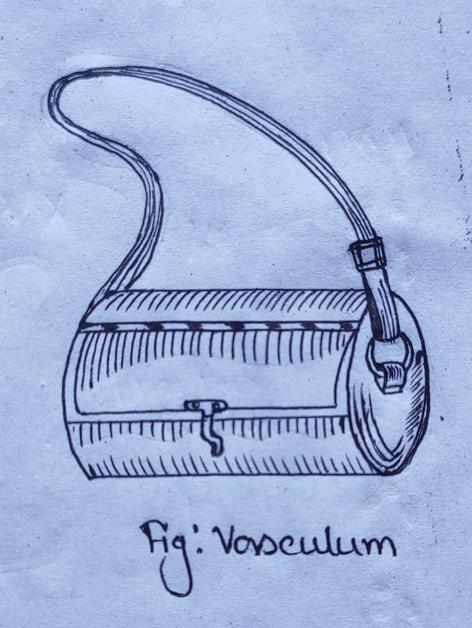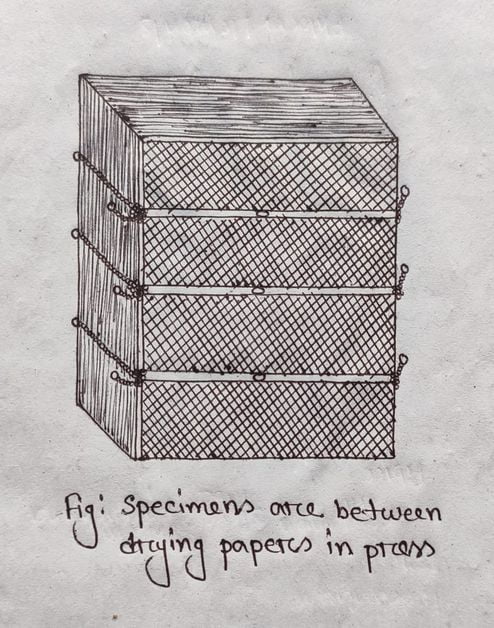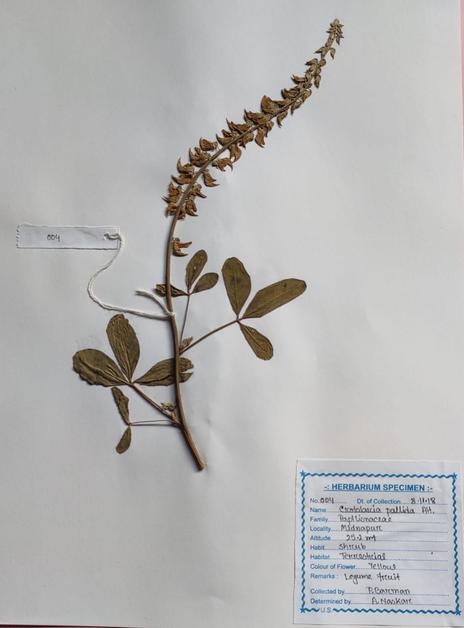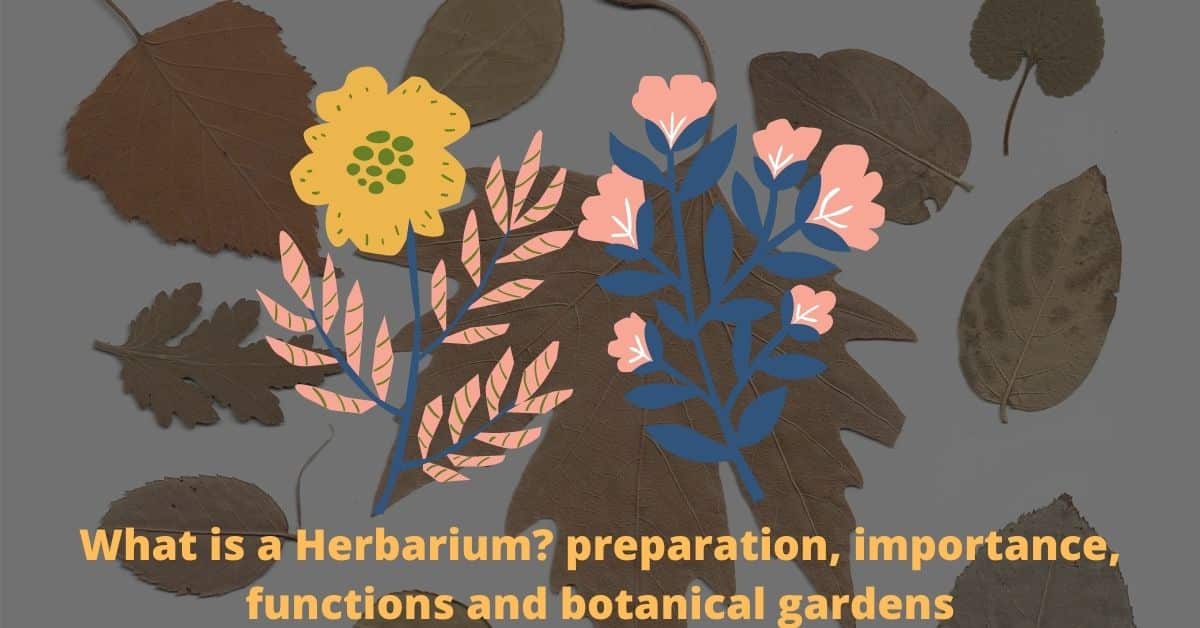A herbarium is a place of the depository of plant specimens in dry conditions. According to H. M. Lawrence (1967), a herbarium is a collection of plant specimens after dried and pressed, these plant specimens are arranged in the sequence of an accepted classification, and are also available for reference or other scientific studies. In some cases, such as succulents and the specimens unsuitable for pressing are preserved in some preservatives like formaldehyde solution 4-5% or in F.F.A ( Formyl acetic acid).
Preparation of Herbarium
To prepare a herbarium following types of equipment and techniques are generally required:
Types of equipment:
- Secateur: This is useful for cutting the twigs of shrubs and trees for herbarium specimens.
- Digger: The digger is used to take out the important underground part of the plants like rhizome, bulb, corn etc. which may serve as important diagnostic characteristics.

- Pruning shears: The pruning shears are useful to collect the twig from tall trees.
- Vasculum: The vasculum is an elongated container with oval ends generally made of aluminium or tin, used to keep the collected specimens fresh for a long time. It has a hinged tight lid. The vasculum is coated with white paint, thus light is easily reflected and also to locate easily due to its contrast with the green vegetation. A belt is fitted at both the ends, thereby one can carry it like a bag.

- Magnifying lens: sometimes a hand lens is required to observe some characteristics of the plant in the field.
- Plant press: It is made up of two-wire gauge frames of 30cm × 45cm.Three iron plates with two holes, one at each end are fitted at one side of the wire gauge frame at equal distance. Similarly the other is also fitted with another three plates. Six things ropes or chains should tighten at one end with the holes present on both sides of the plates. After placing the plants in between the blotting papers or newspaper, it should be kept between the wire gauge and then tightened properly after passing the rope through the holes of plates of opposite wire gauge frames.

- Photographic equipment: Where preparation of herbarium is difficult and unsuitable then this method is helpful, photographs of plants are also important.
Techniques
Selection and collection of plant species:
Collected plant species must have flowers and fruits (if present). In the case of herbaceous plants should be collected with underground parts but for shrubs and trees, a small twig has collected ( size should be 25 cm).
- Records on Voucher book:
The voucher book usually contains 100pages each. The numbers are maintained serially i.e. from 1-100 and the second book should start with 101 and ends in 200. The voucher book should be printed with the following things:
- i)place of collection.
- ii)field no.
iii) date of collection
- iv) locality
- v) altitude
- vi) habit
vii) name of collector
- Collection in vasculum or polythene bag:
After proper record the plants are collected in a vasculum or in a moist polythene bag, thereby the collected plants or plant parts would remain fresh.
- Pressing of specimens for drying:
Before pressing the plant material should be cleaned from dust.
- Poisoning:
The dried plants are then poisoned by dipping in a saturated solution of mercuric chloride in ethanol or in rectified spirit. After some time the ethanol or rectified spirit evaporates and the specimens become dry.
- Mounting:
The dry poisoned plants are then mounted on a comparatively hard sheet of paper 42cm × 29cm. The mounting is done by gum or cellophane tape. Gum is applied with the help of a brush.
- Labelling:
A label is a rectangular piece of paper of usually 12cm× 10cm, pasted at the lower right of the herbarium sheet.
The label should contain:
- Herbarium specimen
- No
iii. Date
- Name
- Family
- Locality
vii. Altitude
viii. Collected by.
- Identified by.

Important Herbaria of the world
- Museum of Natural History, Paris (1635) … … .. 9,500,000
- Royal Botanic Garden, Kew, England ( 1841)……….more than 7,000,000
- New York Botanic Garden ( NY), (1891) … … . …. 7,000,000
Important Herbaria of India
- Central National Herbarium, Shibpur, Howrah, W. Bengal, ( 1793)…………….2, 500,000
- Herbarium of the Forest Research Institute, Dehradun … … …. … 300,000
- Madras Herbarium, Coimbatore… … … … 150,000
img
Functions of Herbarium
- provides a standard reference of collection and identifying newly collected plants.
- To maintain research of both fundamental and applied aspects.
- To fill the public requirements by giving scientific information in respect of plants, by organising exhibition, training courses.
- To give job and research facilities to the juniors.
- To assist the loan and exchange of plants for different purposes including research.
- To help the students and scholars for collection and easy identification of newly collected plant materials.
Functions of Botanic Garden
- It acts as Institute for different types of botanical research, particularly the flora of that region.
- May act as a training centre to conduct training for the persons interested in tree plantation.
- The plants of the Botanic garden are grown and labelled properly with their scientific name and with a note including the name of its native country.
- Perennial plants of different countries are planted in different plots according to their habitat, thereby students and interested persons are able to get an idea about the vegetation of that country.
- It acts as an educational centre for students.
Importance of Botanic garden
- Botanic gardens play an important role in the ex-situ conservation of plant species.
- It acts as an ‘ outdoor laboratory’ for the students.
- Very important role in maintaining germplasm banks of different plants and act as a depository of ‘ extinct’ and ‘ endangered‘ plants.
- Many Botanic gardens organise popular courses for interested persons about:
- Making of bonsai plants,
- Flowers arrangement
- Preparation and display of dry flowers
- Gardening
- Topiary( pruning of trees or shrubs to get different shapes like different animals and birds).
If you have any query regarding this post, please don’t hesitate to comment below. Thank you.
what is herbarium?
A herbarium is a place of the depository of plant specimens in dry conditions. According to H. M. Lawrence (1967), a herbarium is a collection of plant specimens after dried and pressed, these plant specimens are arranged in the sequence of an accepted classification, and are also available for reference or other scientific studies.
What are the equipments needed for preparing a Herbarium?
1. Secateur, 2. Digger, 3. Pruning shears, 3. Vasculum, 4. Magnifying lens, 5. Plant press, 6. Photographic equipment.

